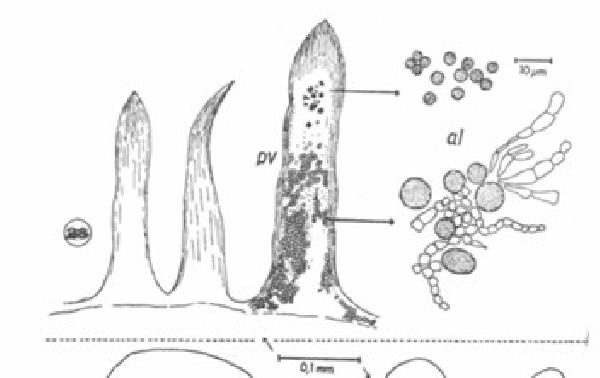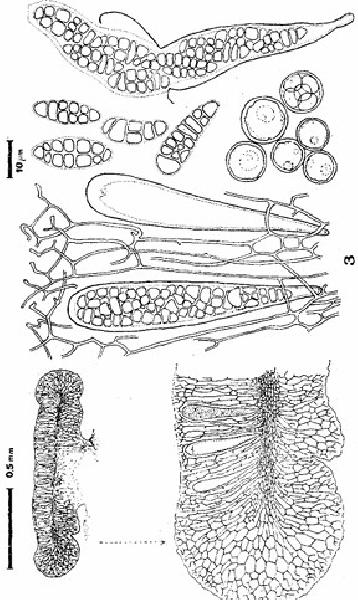Jamesiella anastomosans (P. James & Vězda) Lücking, Sérus. & Vězda
Lichenologist, 37: 165, 2005. Basionym: Gyalideopsis anastomosans P. James & Vězda in Vězda - Folia Geobot. Phytotaxon., 7: 209, 1972.
Synonyms:
Distribution: N - TAA (Nascimbene 2005, Nascimbene & al. 2006e). S - Cal (Puntillo 1996, Puntillo & Puntillo 2004).
Description: Thallus crustose, thinly episubstratic and film-like, smooth or verruculose, glaucous to pale grey, forming discrete, rarely coalescing, up to 1 cm wide patches, often delimited by a pale grey to white prothallus. Hyphophores (thlasidia) usually abundant and crowded in sterile specimens, rare or most often absent in fertile ones, spine-like to bottle-shaped, 0.1-0.5 mm high, often flattened, pale greenish to grey, translucent at the pointed apices, containing both conidia and algae in the central, gelatinous mass of diahyphae. Apothecia lecideine, 0.2-0.6 mm across, sessile and constricted at base, scattered or rarely crowded and contiguous, round to angular, with an orange-red to black-brown disc and a translucent, darker (when wet), smooth or irregularly uneven proper margin. Proper exciple and hymenium of loosely entangled hyphae immersed in a gelatinous matrix. Asci (6-)8-spored, cylindrical-clavate, thickened at apex (tholus), the wall I-, the content K/I+ brown-red. Ascospores muriform or submuriform, hyaline, ellipsoid or subclavate, 20-30 x 6-13 μm. Photobiont chlorococcoid. Spot tests: thallus K-, C-, KC-, P-, UV-. Chemistry: without lichen substances.Note: a mild-temperate lichen also known from New Zealand, found on bark of deciduous, rarely of coniferous trees in humid, undisturbed forests, often on twigs of Abies, more rarely on wooden bridges above small creeks. It is included in the Italian red list of epiphytic lichens as “Endangered” (Nascimbene & al. 2013c).
Growth form: Crustose
Substrata: bark and lignum
Photobiont: green algae other than Trentepohlia
Reproductive strategy: mainly sexual, or asexual by conidia and thalloconidia
Restricted to humid-warm, oceanic areas
Commonnes-rarity: (info)
Alpine belt: absent
Subalpine belt: absent
Oromediterranean belt: absent
Montane belt: extremely rare
Submediterranean belt: absent
Padanian area: absent
Humid submediterranean belt: extremely rare
Humid mediterranean belt: absent
Dry mediterranean belt: absent

Predictive model
Herbarium samples
Growth form: Crustose
Substrata: bark and lignum
Photobiont: green algae other than Trentepohlia
Reproductive strategy: mainly sexual, or asexual by conidia and thalloconidia
Restricted to humid-warm, oceanic areas
Commonnes-rarity: (info)
Alpine belt: absent
Subalpine belt: absent
Oromediterranean belt: absent
Montane belt: extremely rare
Submediterranean belt: absent
Padanian area: absent
Humid submediterranean belt: extremely rare
Humid mediterranean belt: absent
Dry mediterranean belt: absent

Predictive model
| Herbarium samples |
 INDEX FUNGORUM
INDEX FUNGORUM
 GBIF
GBIF
 DOLICHENS
DOLICHENS






